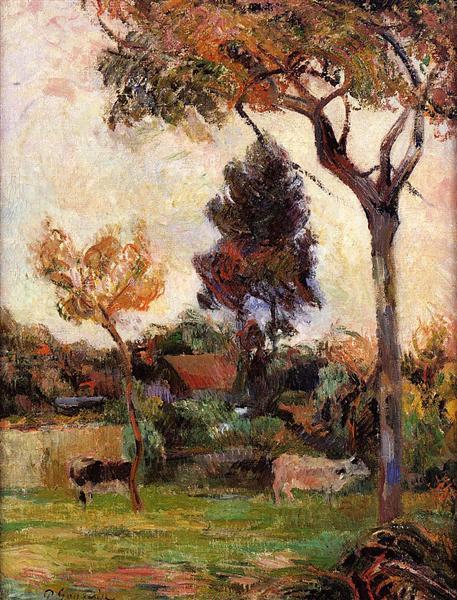Description
The work "Two cows in the Prado" (1884) by Paul Gauguin is a subtle testimony of the innovative approach that the artist printed in his works during his transit for post -impressionism. Animals, represented in a pastoral context, become the center of an image that evokes both the simplicity of rural life and a display of technical virtuosity in the use of color and shape. This painting is an intriguing example of Gauguin's interest in capturing the essence of his surroundings, a search that began in his youth and imbued with peculiarities and nuances throughout his career.
In the composition of "two cows in the Prado", the disposition of the cows, which occupy the central part of the canvas, establishes a strong point of attention. Its bulky forms are defined by a dark contour that distinguishes them from the background, ensuring their prominence in the work. The surrounding environment is painted with a visual treatment that emphasizes luminosity and atmosphere, creating a feeling of open space and fresh air. The cows are placed on an exuberant meadow that is suggested through wide brushstrokes that provide a sense of movement and dynamism.
The use of color in this work is remarkable. Gauguin uses saturated colors that break with the traditional palette, adopting vibrant tones that contribute to an almost dreamlike atmosphere. The Greens of the Prado and the darkened brown of the cows contrast effectively, generating a feeling of depth and a game between the real and the idealized. This chromatic choice not only shows technical skill, but also aligns with the post -impressionist ethos of exploring and expressing sensations through color, instead of limiting itself to the reliable representation.
Although there are no human characters in the work, the symbolic presence of cows implies a connection with the daily life of the people who inhabits the field. Its representation can be interpreted as an observation of rural daily life, a recurring theme in Gauguin's work. This approach reflects the artist's interest in exploring life in the countryside and its inhabitants, something that can also be found in other works where the human figure is the protagonist in the simplicity of the rural environment.
Gauguin, in this period of his career, began to establish his distinctive style, away from the naturalism of his contemporaries. Inspired by his surroundings in Brittany, where he painted many of his subsequent works, as well as by the aesthetics of popular arts and Japanese painting, "two cows in the meadow" can be seen as one of the first manifestations of his desire to pass from a simple reproduction of reality to a more personal and subjective interpretation.
The canvas is a clear precursor of the transition that Gauguin would experience later in his career, where the evocation of emotions and sensations through color and shape would become its distinctive seal. As his work advanced towards greater abstraction, the elements of this piece would remain as a testimony of their academic roots, even while the artist cultivated his path to a more symbolic and characteristic style that would culminate with emblematic works in his later years.
"Two cows in the Prado" is not merely a pastoral representation; It is a reflection of Gauguin's perception about the world around him. In this work, you can see the beginning of an aesthetic narrative that, although brief in its exploration of the animal figure, opens a dialogue with everyday life and landscapes that, perhaps in its simplicity, become a mirror of the human spirit .
KUADROS ©, a famous paint on your wall.
Hand-made oil painting reproductions, with the quality of professional artists and the distinctive seal of KUADROS ©.
Reproduction service paintings With a guarantee of satisfaction. If you are not completely satisfied with the replica of your painting, we refund your money 100%.

